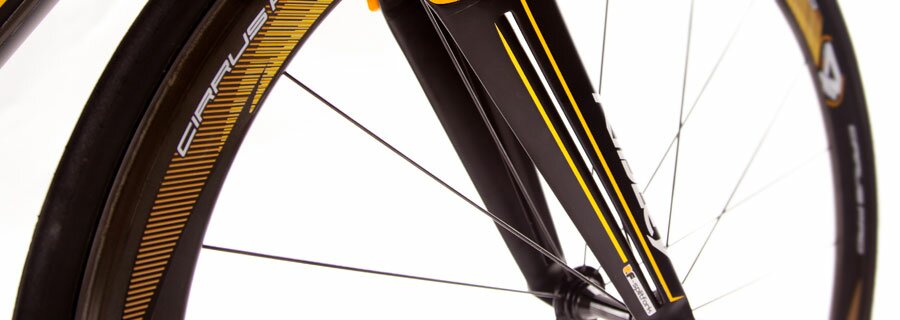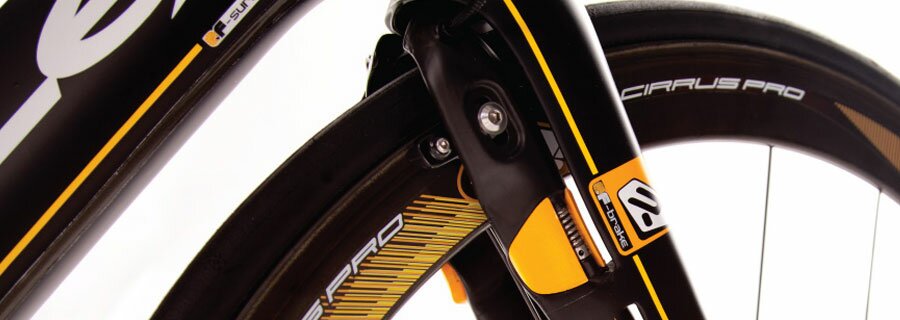SHAPING THE FUTURE BY STARTING WHERE THE OTHERS STOP ...
Most brands work in the same way, only focusing on streamlining the bike with droplet shaped tubes. For us, this is only the beginning. Our engineers, in their constant strive to develop the fastest bike in the world, analyzed aerodynamics to the bone. Throughout years of in-depth wind tunnel testing, they discovered 3 major issues that cause drag and restrain the speed a bike can obtain. They found a solution for each one of them. The result: the FAST-concept. A tripod concept containing 3 groundbreaking technologies.
F-Splitfork™: jet foils which draw air away from the spokes, and counteract on turbulence generated by the wheels. Result: speed!
F-Brake™: the first real integrated brake! The first brake that makes you faster.
F-Surface™: a textured surface applied to strategic locations on the frame, letting air travel smoothly around the frame instead of detaching and creating drag


Most turbulence created by the bike is caused by the wheels (and spokes). At the top of the wheels the spokes are moving forward while colliding with the frontal wind. This causes a major turbulence, creating drag and slowing down the bike. With our splitfork we guide the incoming frontal air away from the spokes and create in this manner an airstream, away from the wheels. In this way, we reduce the interaction of the airstream with the spokes which results in reduced turbulence and drag.
We started our windtunnel test with standing wheels. Then we saw that the best competitor fork had less drag than our F-Splitfork™. Obviously such a test is Non-Significant, because when you ride a bike the wheels are always turning. So we performed a second test with the wheels turning:
Final conclusion:
Drag is increasingly lower on the F-Splitfork™ as wheel speed is increased. The F-Splitfork™ has 7.44 % less drag then the competitor fork used in this test. The data shows the Ridley F-Splitfork™ out-performed the competitor's forks.

Setting a new industry standard by creating a groundbreaking innovation : the first real integrated brake !
There is off course no doubt about the necessity of a brake on a bike! But this brake, like other bike components, creates turbulence and causes drag, restraining the speed a bike can obtain. That's why it has been one of the main goals of bike manufacturers to integrate the brakes as much as possible.
Until now, many efforts have been made, yet no one was able to truly integrate the brake into frame and fork. Following years of in-depth testing, we therefore started developing our own brakes and integrated these into the frame and fork itself.
The result: the ?rst real integrated brake. This innovative setup results in less drag and cleaner lines: a faster, sleeker and better solution.
In other words:
The First brake in the world which makes you faster!
If you see the picture of this unique brake system there/�s no need to tell the aerodynamic advantage of this brake. Normal brakes, which are obvious undesirable obstacles in the airstream, create turbulence while the position and shape of our speed brakes reduces the air resistance to a very minimum. Moreover, creating the brakes like this, we are able to lengthen the F-Splitfork™ from dropout to fork crown, giving the bike even more of an advantage.

The frontal wind has to "pass around" the tubes of the bike, and has to change its direction to follow the profile of the bike. To make it easier for the airstream to follow the profile of the bike and stay close to the bike, the tubes are designed in a droplet shape.
However, even then it's not possible to keep the airstream in touch with the frame at every location. At sudden locations the airstream releases the frame, creating a wake on these locations which increases the drag. Therefore we did extensive wind tunnel testing and used oil mapping technology to locate the places where the wind releases the frame. To avoid the airstream releasing from the frame on these locations, we apply a structure surface on well defined locations in order keep to the wind close to the frame. Which in its turn, reduces drag. Once again optimizing the speed a bike can obtain...














Also @